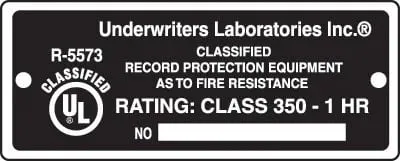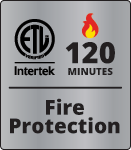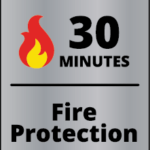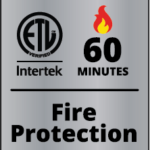Fire Ratings Explained
Regarding fire protection, Alpine Safes’ fire-rated safe collection has been rigorously tested and certified by Underwriters Laboratories (UL) and Intertek (ETL), two of the most respected independent laboratories in the industry. These tests have earned the safes the half-hr., 1-hr., and 2-hr. fire endurance classifications, as well as 30 min., 45 min., 60 min., 90 min., and 120 min. Series of gun safes. When comparing fire ratings, it is vital to understand the significance of these certifications and the protection they provide:
- To make an informed decision, it is essential to consider the results of tests conducted by independent laboratories and those conducted by the factory. While the factory tests may be accurate, it is essential to know that a third party does not verify them and, therefore, could be unreliable. Therefore, weighing the independent laboratory reports and the unverified factory testing is essential to ensure the most thorough and accurate assessment possible.
- Consumers seeking the utmost in fire protection should look for safes tested and certified by Underwriters Laboratories (UL) or Intertek Laboratories (ETL). These two organizations are world-renowned for their rigorous testing standards and stringent certifications, ensuring that only the highest-quality safes are awarded their seal of approval. UL and ETL testing involves exposing the safe to extreme temperatures and evaluating its ability to protect the contents, making it the perfect choice for those seeking reliable fire protection.
- It is vital to verify the fire curve of the furnace to ensure that it holds its specified temperature throughout the fire test. The test should be conducted for two hours, and within the first eight minutes, the furnace should reach a temperature of 1200° F, which should then be maintained for the entire two-hour duration. If the furnace fails to reach the specified temperature or ramps up near the end, it is likely not performing as it should.
- What type of door seals does the product offer? The best seal is a Palusol™ door seal that expands to 7 times its size when temperatures reach 212 degrees, sealing off heat and smoke. Some top-end products use dual seals utilizing a silicone seal as the first defense, protecting the safe until the Palusol™ seal performs its task.
H2 What is a UL Safe Fire Rating?

This fire safe must meet strict requirements to prove its worth. It must be able to maintain an interior temperature that is below 350°F when exposed to fire for an hour at 1700°F or for two hours at 1850°F, with the label/class being 350°F-one hour and 350°F-two hour respectively.
To be considered a success, the fire safe must also pass the Fire Endurance Test, Explosion Hazard Test, and the Fire/Impact Test. These tests all have their criteria that must be met for the safe to be deemed satisfactory.
UL Fire Endurance Test
The safe is subjected to a rigorous fire test, where heat sensors and paper are placed inside the unit before it is locked. The furnace is then regulated to reach a maximum temperature of 1700°F for one hour or 1850°F for two hours and then allowed to cool without opening the furnace. To ensure the unit’s safety, the internal temperature is monitored throughout the entire test and during the cooling period and must never exceed 350°F. After the unit cools, it is opened and examined for usability. The locks and parts fastenings are carefully inspected to ensure they are still secure, and the interior is examined for any signs of heat transmission. This process guarantees the safe will be able to protect its contents from a fire.
UL Explosion Hazard Test
The safe is secured and placed into a furnace that has been preheated to a temperature of 2000°F. This temperature is maintained for 30 minutes, while a 2-hour test requires 45 minutes. If no explosion occurs during this time, the unit is permitted to cool down without opening the furnace doors. Once the unit has cooled, it is opened and inspected for usability. The locks and fastening parts are examined for security, and the safe’s interior is inspected for any visible signs of excessive heat transfer.
Fire Impact Test (Brand Option)
After the explosion hazard test, the safe is removed from the furnace and, within two minutes, is dropped from a height of thirty feet onto a bed of brick on a heavy concrete base. Following the impact, the unit is inspected to check for deformation, rupture of components, damaged insulation, and any other openings in the unit’s interior. Once cooled, the unit is turned over and reheated to 1550°F for 30 min (two hours, 45 minutes at 1638°F). After this, the unit is opened and assessed for usability. The locking mechanisms and fastenings of the unit are then checked for strength and security, and the interior is studied to determine if there is any visible sign of excessive heat transmission.
ETL Safe Fire Rating Explained
For over a century, Intertek ETL Testing Laboratories has been performing tests to assess the reliability and performance of products. With laboratories located in over 14 countries, they have become an internationally renowned name. Currently, the company is the gold standard for gun-safe fire testing. Suppose you want to compare the fire resistance of different gun safes.
In that case, you should always consider the reports generated by independent labs rather than relying on the unverified results from manufacturing companies. As technology evolves, businesses increasingly seek more secure solutions to protect their data.





One of the most critical security measures companies can take is to ensure that their data is securely stored and accessed, and this is where ETL Safe Fire Rating comes in. ETL Safe Fire Rating is a system developed by ETL Testing Laboratories, Inc. It is a set of tests and ratings that measure a product’s fire resistance and performance. The system is designed to evaluate the ability of a product to protect against fire, smoke, and heat. It is based on the UL (Underwriters Laboratories) Fire Endurance Test Standard, UL 1479. The ETL Safe Fire Rating system consists of two parts.
The first part is the fire resistance test, which evaluates the product’s ability to withstand fire and protect against smoke and heat. The second part is the performance test, which measures how well the product works in a fire situation. The performance test measures factors such as the time it takes for the product to activate, its ability to detect a fire, and the amount of smoke and heats it can resist. The ETL Safe Fire Rating system is designed to provide companies with a comprehensive evaluation of the fire safety of their products. It provides a clear, objective rating of the product’s fire resistance and performance, which can help companies make informed decisions about their security measures.
The system also helps companies to identify and address any potential fire safety issues that may exist in their products. The ETL Safe Fire Rating system is an essential tool for companies looking to ensure that their data is securely stored and accessed. It is an effective way to evaluate products’ fire safety and identify and address any fire safety issues that may exist. Companies should consider using the ETL Safe Fire Rating system to ensure their data is safe and secure.

